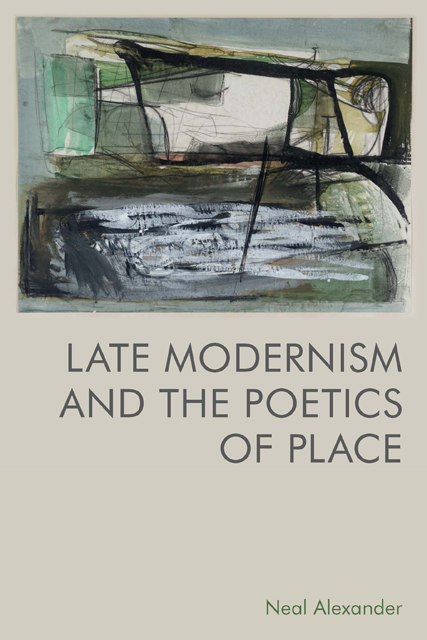Book contents
- Frontmatter
- Contents
- Acknowledgements
- Introduction
- 1 David Jones: The Sites of History
- 2 Basil Bunting’s Regional Modernism
- 3 W. S. Graham: Between Places
- 4 Lorine Niedecker: Life by Water
- 5 Charles Olson’s Mappemunde
- 6 Gwendolyn Brooks: From Bronzeville to the Warpland
- Conclusion: After Late Modernism
- Notes
- Bibliography
- Index
6 - Gwendolyn Brooks: From Bronzeville to the Warpland
Published online by Cambridge University Press: 18 November 2022
- Frontmatter
- Contents
- Acknowledgements
- Introduction
- 1 David Jones: The Sites of History
- 2 Basil Bunting’s Regional Modernism
- 3 W. S. Graham: Between Places
- 4 Lorine Niedecker: Life by Water
- 5 Charles Olson’s Mappemunde
- 6 Gwendolyn Brooks: From Bronzeville to the Warpland
- Conclusion: After Late Modernism
- Notes
- Bibliography
- Index
Summary
During the mid-1940s, the poet Gwendolyn Brooks lived with her husband and young son in a one-room kitchenette apartment at 623 East 63rd Street, on the southern edge of Bronzeville, Chicago. Situated at an intersection and overlooking a stretch of the L-train line, Brooks's flat was also, for a short time, one of the meeting places of African American late modernism, a venue for parties attended by many of the writers, artists, musicians, and photographers associated with the Chicago Black Renaissance. When Brooks threw a party for her friend Langston Hughes, the Harlem Renaissance poet, perhaps 100 people squeezed into her tiny kitchenette. Moreover, the apartment was also a ‘scene of writing’ for Brooks, the place where ‘the everyday practices, encounters, and networks’ of her social life were worked into poetry. Brooks remarks in her autobiography, Report from Part One (1972): ‘If you wanted a poem, you only had to look out of a window. There was material always, walking or running, fighting or screaming or singing’. That is, Brooks's apartment window offered a panorama of the everyday lives of her fellow Bronzeville citizens, whose activities provide the raw ‘material’ from which her poems are fashioned or ‘distilled’.
In this chapter, I examine the centrality of Bronzeville and its people to Brooks's late modernist poetry in detail, with particular attention to her representations of living spaces and the public spaces of the city's streets. I also argue that Brooks's work, when considered as a whole, reveals Bronzeville to be a mutable and transient phenomenon, a place-in-process that is shaped and reshaped by Chicago's histories of migration, racial segregation, and urban redevelopment in the period from the end of the First World War until the 1960s. Brooks was born at the beginning of this period, in 1917, began to publish her poetry during the 1930s, when Bronzeville acquired its name, and underwent a profound aesthetic and political realignment in the late 1960s, when Bronzeville's identity as a black urban community and cultural hub had dwindled to little more than a memory. Thereafter, her geographical imagination is largely decoupled from the streets and kitchenette buildings of Bronzeville, turning instead to the allegorical landscapes of the American Warpland in the post-Civil Rights era and to the wider solidarities of the African diaspora.
- Type
- Chapter
- Information
- Late Modernism and the Poetics of Place , pp. 171 - 198Publisher: Edinburgh University PressPrint publication year: 2022



